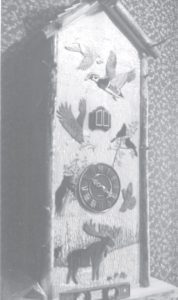SOLON & BEYOND, Week of June 15, 2017
 by Marilyn Rogers-Bull & Percy
by Marilyn Rogers-Bull & Percy
grams29@tds.net
Solon, Maine 04979
Good morning, dear friends. Don’t worry, be happy!
This is one of those mornings when I sit down in front of my computer with very little real news to share with you. I did receive an e-mail from Carol Dolan with an update on Embden Community Center events. On June 24, Steve & The Good Ole Boys Band will be playing there from 7 – 11 p.m. Kitchen open. And on Sunday, June 25 Country/Open Mic from 1 – 4 p.m., second and fourth Sundays. By donation. Kithchen open.
I can’t seem to stress enough how much I appreciate any news that is sent to me. But…if I don’t receive it in time for my deadline, I can’t get it in in time.
Some of you have told me how much you like to read about my stories of visiting up to where my home town of Flagstaff used to be. Lief and I went up there to be with Dave and ‘Pete’ at their camp for a couple of days this weekend. Peter and Sherry went up also and we all had a wonderful time.
Each year as I get another year older, my memories are very dear to me. Peter and I were out on the porch and I was telling him that I had been out there trying to figure out just where it was that the house where I had lived was compared to where we were sitting. Of course I have many pictures of how it used to look but it is still hard to pin point the exact spot.
Even though the hoards of black flies and mosquitoes were enough to drive us nuts, (it does seem to me, they were worse than I could remember), we had a wonderful time….and the food, as always, was out of this world! I kind of twisted Dave’s arm, and he made his famous popovers for breakfast one morning. Delicious! Peter cooked breakfast the next morning, and can’t begin to describe how great it was. So you can see we ate well along with sharing some good special laughter and love.
They always request that I bring cookies, which I did, but I got brave and tried a new recipe for a dessert. It looked really simple and easy to make, but I couldn’t imagine what the finished product would look or taste like…. but, it got rave reviews! I’m going to share this most delectable recipe called, “Simple Strawberry Rhubarb Dessert;” 4 cups rhubarb, 1 small pkg. strawberry Jello, 1 cup sugar, 1 yellow cake mix, 1 cup water. Sprinkle ingredients in a 9 x 13-inch pan in order written. Bake one hour at 350° F. Serve warm with vanilla ice cream. (Must not leave out that I bummed the rhubarb from Peter.) Hope you try this recipe and enjoy it as much as we did.
And so for Percy’s memoir which is called, “Lord, Give Us Words: “Give us cheering words for the lonely, Comforting words that bless… Encouraging words for the hopeless, Smiling words to bring happiness. Give us patient words for the struggling, Courteous words, so that rudeness ends, Kind words for those who upset us… Forgiving words for those who offend . Give us faith-filled words that are positive, That inspire optimism and zeal. Teach us “the time to keep silence” And the “time to speak” and to feel. May we wait on You with prayerful thoughts, For the wisdom You impart. Give us acceptable words to express, The meditations of our hearts. (words by Micky Meyer Mathewson.)


 ERIC’S TECH TALK
ERIC’S TECH TALK And it got me thinking. Is there any law on the books requiring an Artificial Intelligence to tell you it is an artificial intelligence? After a bit of research, I found
And it got me thinking. Is there any law on the books requiring an Artificial Intelligence to tell you it is an artificial intelligence? After a bit of research, I found  SCORES & OUTDOORS
SCORES & OUTDOORS

 REVIEW POTPOURRI
REVIEW POTPOURRI



 TRAINING YOUR PERFORMANCE DOG
TRAINING YOUR PERFORMANCE DOG


